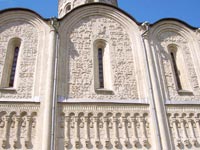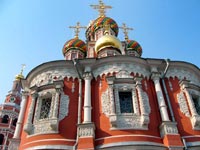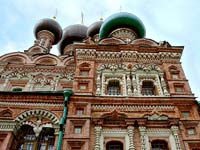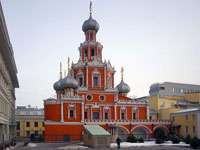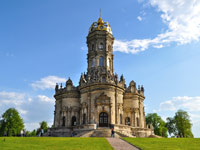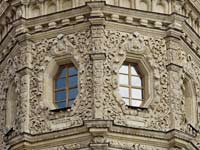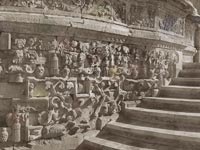At the end of the XVII century, during the so-called "Naryshkin Baroque", many significant, mainly church buildings were decorated with magnificent platbands, diverse in their carved decor. For example, the windows of the Faceted Chamber received such a rich carved decoration. Stroganov Church in Nizhny Novogorod, the Church of St. Sergius with a Refectory (Refectory Church, 1686-1692) in the Trinity-Sergius Lavra in Sergiev Posad. A magnificent carved portal, capitals, carved stone columns, elegant platbands, and rosettes are a characteristic detail for the Naryshkin Baroque, crowning the first and second tiers. The Church of the Resurrection of the Living (the village of Kolychevo) has similar details, the Church of the XVII century, the Church of the Intercession of the Most Holy Theotokos in Fili, the Church of the Icon of the Mother of God "The Sign" in the Sheremetyevo Courtyard, the buildings of the Novodevichy Monastery in Moscow are also the brightest examples of this time, and the Church of the Sign in the village of Dubrovitsy in the Moscow region is an absolute diamond of the end of the XVII century. It was entirely composed of blocks of white stone, the outer part of which was given the shape of rust-squares. All of it is a carved miracle, a hymn to the stone-cutting art of ancient masters. Deep, relief, stone carvings are decorated not only with facades, platbands, cornices and an octagon-all covered with carpet white stone carvings, but also the entire basement and even the risers.
Russia, 199034, St. Petersburg, Line 14th V.O., house 7, letter A, BC "Preobrazhensky"

(812) 322-09-40
(812) 322-34-40
Russia became the successor of Byzantium
At the end of the XVII century, during the so-called "Naryshkin Baroque", many significant, mainly church buildings were decorated with magnificent platbands, diverse in their carved decor. For example, the windows of the Faceted Chamber received such a rich carved decoration. Stroganov Church in Nizhny Novogorod, the Church of St. Sergius with a Refectory (Refectory Church, 1686-1692) in the Trinity-Sergius Lavra in Sergiev Posad. A magnificent carved portal, capitals, carved stone columns, elegant platbands, and rosettes are a characteristic detail for the Naryshkin Baroque, crowning the first and second tiers. The Church of the Resurrection of the Living (the village of Kolychevo) has similar details, the Church of the XVII century, the Church of the Intercession of the Most Holy Theotokos in Fili, the Church of the Icon of the Mother of God "The Sign" in the Sheremetyevo Courtyard, the buildings of the Novodevichy Monastery in Moscow are also the brightest examples of this time, and the Church of the Sign in the village of Dubrovitsy in the Moscow region is an absolute diamond of the end of the XVII century. It was entirely composed of blocks of white stone, the outer part of which was given the shape of rust-squares. All of it is a carved miracle, a hymn to the stone-cutting art of ancient masters. Deep, relief, stone carvings are decorated not only with facades, platbands, cornices and an octagon-all covered with carpet white stone carvings, but also the entire basement and even the risers.
Art carving on a stone
Architecture of Portuguese complexes
Pskov and Vladimir architecture
Т. Ефимова







 Site search
Site search